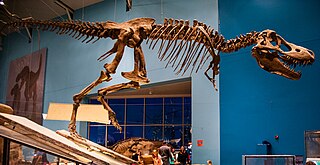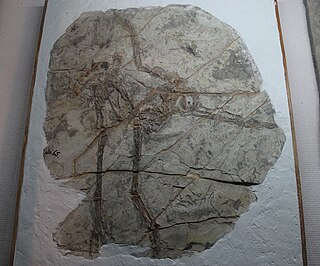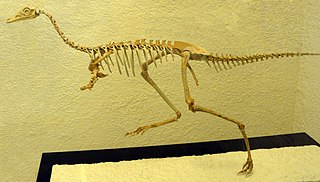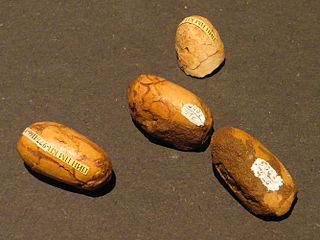
Tarbosaurus is a genus of tyrannosaurine theropod dinosaur that lived in Asia about 70 million years ago, during the Maastrichtian age at the end of the Late Cretaceous period, considered to contain a single known species: Tarbosaurus bataar. Fossils have been recovered from the Nemegt Formation of Mongolia, with more fragmentary remains found further afield in the Subashi Formation of China.

Protarchaeopteryx is a genus of turkey-sized feathered theropod dinosaur from China. Known from the Jianshangou bed of the Yixian Formation, it lived during the early Aptian age of the Early Cretaceous, approximately 124.6 million years ago. It was probably a herbivore or omnivore, although its hands were very similar to those of small carnivorous dinosaurs. It appears to be one of the most basal members of the Oviraptorosauria, closely related to Incisivosaurus, or a taxon slightly less closely related to birds than oviraptorosaurs were.

Anserimimus is a genus of ornithomimid theropod dinosaur, from the Late Cretaceous Period of what is now Mongolia. It was a lanky, fast-running animal, possibly an omnivore. From what fossils are known, it probably closely resembled other ornithomimids, except for its more powerful forelimbs.

Deinocheirus is a genus of large ornithomimosaur that lived during the Late Cretaceous around 70 million years ago. In 1965, a pair of large arms, shoulder girdles, and a few other bones of a new dinosaur were first discovered in the Nemegt Formation of Mongolia. In 1970, this specimen became the holotype of the only species within the genus, Deinocheirus mirificus; the genus name is Greek for "horrible hand". No further remains were discovered for almost fifty years, and its nature remained a mystery. Two more complete specimens were described in 2014, which shed light on many aspects of the animal. Parts of these new specimens had been looted from Mongolia some years before, but were repatriated in 2014.

Avimimus, meaning "bird mimic", is a genus of oviraptorosaurian theropod dinosaur, named for its bird-like characteristics, that lived in the late Cretaceous in what is now Mongolia, around 85 to 70 million years ago.

Adasaurus is a genus of dromaeosaurid dinosaur that lived in Asia during the Late Cretaceous period about 70 million years ago. The genus is known from two partial specimens found in the Nemegt Formation of Mongolia that were partially described in 1983 by the paleontologist Rinchen Barsbold.

Mononykus is a genus of alvarezsaurid dinosaur that lived during the Late Cretaceous in what is now Asia on the Nemegt Formation, about 70 million years ago.

Gobipteryx is a genus of prehistoric bird from the Campanian Age of the Late Cretaceous Period. It is not known to have any direct descendants. Like the rest of the enantiornithes clade, Gobipteryx is thought to have gone extinct near the end of the Cretaceous.

Nemegtomaia is a genus of oviraptorid dinosaur from what is now Mongolia that lived in the Late Cretaceous Period, about 70 million years ago. The first specimen was found in 1996, and became the basis of the new genus and species N. barsboldi in 2004. The original genus name was Nemegtia, but this was changed to Nemegtomaia in 2005, as the former name was preoccupied. The first part of the generic name refers to the Nemegt Basin, where the animal was found, and the second part means "good mother", in reference to the fact that oviraptorids are known to have brooded their eggs. The specific name honours the palaeontologist Rinchen Barsbold. Two more specimens were found in 2007, one of which was found on top of a nest with eggs, but the dinosaur had received its genus name before it was found associated with eggs.

The Nemegt Formation is a geological formation in the Gobi Desert of Mongolia, dating to the Late Cretaceous. The formation consists of river channel sediments and contains fossils of fish, turtles, crocodilians, and a diverse fauna of dinosaurs, including birds.

Caenagnathidae is a family of derived caenagnathoid dinosaurs from the Cretaceous of North America and Asia. They are a member of the Oviraptorosauria, and relatives of the Oviraptoridae. Like other oviraptorosaurs, caenagnathids had specialized beaks, long necks, and short tails, and would have been covered in feathers. The relationships of caenagnathids were long a puzzle. The family was originally named by Raymond Martin Sternberg in 1940 as a family of flightless birds. The discovery of skeletons of the related oviraptorids revealed that they were in fact non-avian theropods, and the discovery of more complete caenagnathid remains revealed that Chirostenotes pergracilis, originally named on the basis of a pair of hands, and Citipes elegans, originally thought to be an ornithomimid, named from a foot, were caenagnathids as well.

Yungavolucris is a genus of enantiornithean birds. It contains the single species Yungavolucris brevipedalis, which lived in the Late Cretaceous. The fossil bones were found in the Lecho Formation at estancia El Brete, Argentina."Yungavolucris brevipedalis" means "Short-footed Yungas bird". The generic name, Yungavolucris is after the Yungas region + the Latin volucris, which translates to "bird". The specific name brevipedalis is from the Latin brevis, which means "short", + pedalis, from the Latin pes, meaning "foot".
Neogaeornis is a controversial prehistoric genus of diving bird. The single known species, Neogaeornis wetzeli, was described from fossils found in the Campanian to Maastrichtian Quiriquina Formation of Chile. It lived about 70-67 million years ago. It remains known from the single tarsometatarsus described in 1929 by Lambrecht, and today housed in the Paläontologisches Institut und Museum in Kiel, Germany.
Asiahesperornis is a prehistoric foot-propelled diving toothed flightless bird genus from the Late Cretaceous. The single known species is Asiahesperornis bazhanovi. It lived in what today is Kazakhstan, at its time the shores of the shallow Turgai Sea.

Parahesperornis is a genus of prehistoric flightless birds from the Late Cretaceous. Its range in space and time may have been extensive, but its remains are rather few and far between, at least compared with its contemporary relatives in Hesperornis. Remains are known from central North America, namely the former shallows of the Western Interior Seaway in Kansas. Found only in the upper Niobrara Chalk, these are from around the Coniacian-Santonian boundary, 85-82 million years ago (mya).
Pasquiaornis is a prehistoric flightless bird genus from the Late Cretaceous. It lived during the late Cenomanian, between 95 and 93 million years ago in North America.
Canadaga is a flightless bird genus from the Late Cretaceous. The single known species is Canadaga arctica. It lived in the shallow seas around what today is Bylot and Devon Islands in Nunavut, Canada. Its fossils were found in rocks dated to the Campanian to mid-Maastrichtian age, about 67 million years ago.

Potamornis is a prehistoric bird genus that dated back to the late Maastrichtian age of the late Cretaceous period. Its scrappy remains were found in the Lance Formation at Buck Creek, USA, and additional possible remains were found in the upper Hell Creek Formation of Montana, dated to the Danian age of the Paleogene period, though these may have been reworked. A single species was named and described in 2001: Potamornis skutchi.

Oksoko is a genus of oviraptorid dinosaur from the Late Cretaceous of Asia, that lived in what is now the Nemegt Formation in Mongolia. It includes the type species Oksoko avarsan.

Natovenator is a genus of halszkaraptorine dromaeosaurid dinosaur from the Late Cretaceous Barun Goyot Formation of Mongolia. The genus is known from a single species, N. polydontus. Natovenator is crucial to the understanding of halszkaraptorines due to it providing more support for the semi-aquatic lifestyle that has been proposed for this clade. This discovery is important as the semi-aquatic lifestyles of halszkaraptorines was contested in early 2022.
































